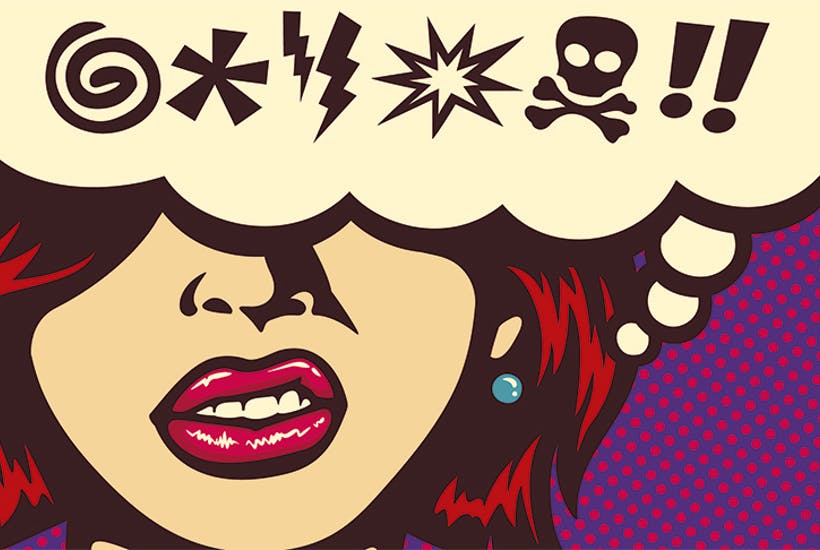Jonathon Green is a tosher. As a lexicographer he dives into archives and emerges with armfuls of slangy curios, such as ‘bell-polisher’ and ‘bitchin’. In Sounds & Furies he sifts English slang from tosheroons as diverse as the Wife of Bath to Fast Times at Ridgemont High.
Green’s passion for his subject is infectious. His corpus of 110,000 slang words and phrases, published in 2010 as Green’s Dictionary of Slang, is filled with coinages both common and rare. In his latest volume, he’s set himself the challenge of unlocking women’s love-hate relationship with slang. As he says at the beginning, we know plenty about the status of women in slang, but not much about how women use it.
He offers plenty of examples of women coiners. Female reporters, online forums popular with young lesbians and even Mumsnet turn up some interesting nuggets. He has a great eye for lexicographical treasures he finds lying around. But reading suggests — and the index confirms — that men writing either about or as women (which Green refers to as ‘ventriloquising’) account for more than half of the slang in the book. Women’s actual words make up far less.
It’s in the seedy underbelly of erotica that the angry, dirty, funny side of women’s tongues finds freedom
When scouring the archives, women’s words are inevitably buried far deeper than men’s. It’s not that historical female characters are absent from the book. Mary Frith, the cross-dressing thief and pimp known as Moll Cutpurse, takes up a good 25 pages. But her supposed words never come from her directly. Instead, they are the product of a dozen different male writers from the 17th to the 20th centuries. From the playwrights Middleton and Dekker to the sociologist John McMullen we see only what men thought of Mary’s deeds, and how men thought she must have spoken.
And there’s the rub: Green has set himself an unenviable task. How can he discover what women were really saying when, for so much of history, they were excluded from the education and access that would have allowed them to publish pamphlets and plays that the modern lexicographer could trawl?
More recent years provide a richer vein of women-coined slang. For example, Enid Blyton and Angela Brazil are credited with several inventions, including the fantastic ‘twiggez-vous?’ — do you understand? — which I shall be adopting instanter. How I wish Angela Brazil had sat alongside P.G. Wodehouse in my school library. As Green points out, when women write young women, the girls are boisterous and unsexual. I was somewhat surprised that he gives equal weight to Alan Warner as a source of teenage girls’ language. Warner’s novel The Sopranos describes a group of teenage girls on a choir trip. Green writes that ‘sex is constant’ and Warner’s girls are ‘hardly wide-eyed innocents’, without ever once raising the possibility that a middle-aged man writing about teenage girls wanting to have sex with middle-aged men may have something other than faithful anthropology in mind.
Green really does seem to want to understand what it is that women get out of slang. The foreword, by Kate Lister, is a great opening act, a reminder that women have always carved a life at the margins. Green also opens his introduction with a quotation from Patrick O’Brian’s The Wine-Dark Sea: ‘Conquest, rape, subjugation: have women a private language of the same nature, I wonder?’
Indeed we do. I’ve scoured the book to try to find the slangy warnings women give each other about men, such as ‘hands’, ‘crunkle’ (creepy uncle), ‘pornstache’, ‘skeevy’, NSIT (not safe in taxis) and ‘NSFL’ (not safe for life). Marginalised groups have ways of letting off linguistic steam, but only where it feels safe, usually far from the light of mainstream publication. It’s in social media and online life that women’s talk throws off its shackles. In recognition of this, the book ends with a nine-page glossary of online lesbian slang. Here Green remarks on the ‘amateur status’ of the women who compiled the list, but it is in precisely these informal settings that marginalised language flourishes.
It’s not Green’s fault that women’s slang takes root in the shadows, in the annals of Tumblr, LiveJournal and Archive of Our Own for example. Mumsnet may have its penis beakers, but it’s in the seedy underbelly of slashfic and erotica, from which only E.L. James has so far stabbed at the stratosphere, that the angry, dirty, funny, flirty side of women’s tongues finds freedom. These are the places that Green needs to venture if he is to find today’s whores of phwoar.
When it comes to distaff dirtiness, mainstream males such as Dickens and Dekker make easy pickings, but Green finds the greatest treasures when he mudlarks on the margins. In Sounds & Furies, he has dredged up some gems, but the setting they’re mounted in is still decidedly male.






Comments